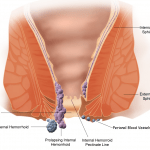Rectal Examination for Hemorrhoids and Other Colo-Rectal Conditions
 Rectal Examination: An Overview
Rectal Examination: An Overview
A rectal examination is a diagnostic examination frequently administered in patients with hemorrhoids or other colo-rectal conditions. During the examination, the physician first makes a visual inspection of the area external to the anal opening to check for external hemroids or fissures. Once that is accomplished, the doctor will use a gloved finger to palpate the lower rectum and assess the neuromuscular function of the perianal area.
The procedure itself is very simple and usually not painful. Some patients who have hemroids may experience discomfort and even bleeding, however, due to inflamed hemorrhoids interfering with the rectal examination.
Application of Rectal Examination
Rectal examination is a useful tool in diagnosing both internal and external hemorrhoids, although internal hemroids in their early stages may sometimes be difficult to detect through digital palpation, due to the tissue being relatively soft. A sigmoidoscopy, a procedure where a scope is inserted into the last part of the colon, may be necessary for hemroids diagnosis in those cases.
Rectal bleeding and blood in the stool, two common symptoms of hemorrhoids, are two conditions which will prompt a doctor to perform a rectal examination. Rectal examination may also be used to collect a stool sample when blood is present.
In addition to hemorrhoids and that condition’s related symptoms, rectal examination can be used to detect prostate problems in men. This includes both enlarged prostate and the presence of tumors in the prostate. Rectal examination may also be used as a diagnostic tool for men who are experiencing frequent urination.
In women, rectal examination is commonly included by most doctors as part of a woman’s regular annual checkup along with a pelvic examination and a Pap smear. Rectal examination may be used to help diagnose reproductive issues in the ovaries and uterus, and may also be utilized when a woman has been experiencing vaginal bleeding and pelvic pain.
In addition to detecting irregularities like hemroids in the rectal tissue, rectal examination can detect cancer or tumors in the area. Since the procedure only has limited diagnostic insight into the colon, however, additional tests will usually be performed for patients who suffer from colo-rectal cancer.
Finally, rectal examination is often employed before a sigmoidoscopy or the more invasive colonoscopy to ensure that nothing is blocking the anal canal before a scope is inserted.
Conclusion
Rectal examination is a quick and relatively simple diagnostic tool that can be employed for hemorrhoids and a number of other conditions. Additionally, it can serve as a good first step when used in conjunction with other diagnostic procedures to confirm the presence of hemroids and other colo-rectal issues.